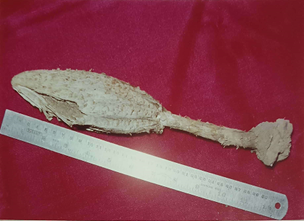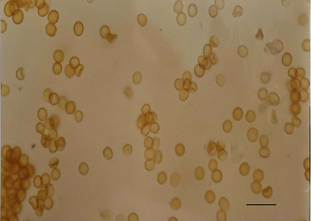Podaxis beringamensis M.J.Priest et M.Lenz, Systematic Botany 12: 109-116 (1999) Fig. 5
MycoBank number: MB 19269; Index Fungorum number: IF 19269; Facesoffungi number: FoF 09749;
Fruiting body– stipitate, 15–35 cm in height, dull-white in colour, dry, scaly and perhaps the tallest specimen collected during and present surveys. Peridium – up to 15 cm high and 4.5 cm in diameter, sub-conical in shape with an acute apex. Exoperidium –scaly and flaking to expose the endoperidium. Endoperidium –pale to dark brown, smooth to longitudinally lacerate and exposing the gleba. Stipe –straight to curved, sometimes twisted, smooth, white to brown, upto 5 cm wide at the base, bulbous and narrowing at the apex. Gleba –ochraceous to deep brown to black at maturity. Spores –oval to elliptical with a truncate base, smooth, yellow when immature, becoming deep reddish brown at maturity, 5.0–6.0 × 7.0–7.5 µm, double walled with an apical pore.
Ecology and distribution: This species was reported to be occuring on termite mounds in Australia by Priest & Lenz (1999). Gay (1970) reported the termite mounds as an ideal habitat for P. beringamensis. Accordingly, the walls of the mounds are usually composed of semi-digested plant material, soil and other organic matter and the relative humidity within termite mounds is near saturation with stable temperatures.
Specimens examined: JNV/Mycl/163, 21 August 2018 in Zone IA and IIB on sandy soil associated with termite nests collected by Sanjay Panwar. 25°45’0.00″N 71°22’48.00″E Barmer, elevation:227 m (745 ft ), 28°01’3.43″N73°18’53.82″E Bikaner, elevation:242 m (794 ft) 26°55’3.47″N70°54’13.93″E Jaisalmer, elevation: 225 m (738 ft), 28°18’0.00″N74°57’0.00″E Churu, elevation:292 m (958 ft), 26°16’6.28″N73°00’21.38″E Jodhpur, elevation:231 m (758 ft), 25°20’44.09″N72°36’56.12″E Jalore, elevation:178 m (584 ft), 25°46’12.00″N73°19’48.00″E Pali, elevation: 214 m(702 ft), 24°53’18.17″N72°50’52.58″E Sirohi, elevation:321 m (1,053 ft).
Note – The description of the above genera resembles that of Priest & Lenz (1999) from Australia in terms of the dimensions of the fruiting body, characteristics and colour of endo and exoperidium except for minor differences in the size of the spores. This species is distinguished by its elliptical spores and tall stature. This species is a new record for India.

a

b
Fig. 5–a Fruiting body of Podaxis beringamensis.b Spores. Scale bar: b= 20 µm.
